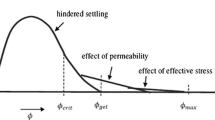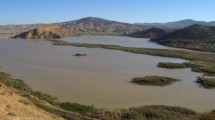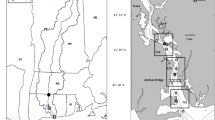Abstract
Estuarine and coastal sediment transport is characterised by the transport of both sand-sized particles (of diameter greater than 63 μm) and muddy fine-grained sediments (silt, diameter less than 63 μm; clay, diameter less than 2 μm). These fractions are traditionally considered as non-cohesive and cohesive, respectively, because of the negligible physico-chemical attraction that occurs between sand grains. However, the flocculation of sediment particles is not only caused by physico-chemical attraction. Cohesivity of sediment is also caused by biology, in particular the sticky extra-cellular polymeric substances secreted by diatoms, and the effect of biology in binding sediment particles can be much larger than that of physico-chemical attraction. As demonstrated by Manning (2008) and further expanded in part 1 of this paper (Manning et al., submitted), the greater binding effect of biology allows sand particles to flocculate with mud. In many estuaries, both the sand and fine sediment fractions are transported in significant quantities. Many of the more common sediment transport modelling suites now have the capability to combine mud and sand transport. However, in all of these modelling approaches, the modelling of mixed sediment transport has still essentially separated the modelling of sand and mud fractions assuming that these different fractions do not interact except at the bed. However, the use of in situ video techniques has greatly enhanced the accuracy and reliability of settling velocity measurements and has led to a re-appraisal of this widely held assumption. Measurements of settling velocity in mixed sands presented by Manning et al. (2009) have shown strong evidence for the flocculation of mixed sediments, whilst the greater understanding of the role of biology in flocculation has identified mechanisms by which this mud-sand flocculation can occur. In the first part of this paper (Manning et al., submitted), the development of an empirical flocculation model is described which represents the interaction between sand and mud particles in the flocculation process. Measurements of the settling velocity of varying mud-sand mixtures are described, and empirical algorithms governing the variation of settling velocity with turbulence, suspended sediment concentration and mud-sand content are derived. The second part of this paper continues the theme of examination of the effects of mud-sand interaction on flocculation. A 1DV mixed transport model is developed and used to reproduce the vertical transport of mixed sediment fractions. The 1DV model is used to reproduce the measured settling velocities in the laboratory experiments described in the part 1 paper and also to reproduce measurements of concentration of mixed sediments in the Outer Thames. In both modelling exercises, the model is run using the algorithms developed in part 1 and repeated using an assumption of no interaction between mud and sand in the flocculation process. The results of the modelling show a significant improvement in the ability of the 1DV to reproduce the observed sediment behaviour when the empirical equations are used. This represents further strong evidence of the interaction between sand and mud in the flocculation process.











Similar content being viewed by others
References
Cuthbertson A, Dong P, King S, Davies P (2008) Hindered settling velocity of cohesive/non-cohesive sediment mixtures. Coast Eng 55:1197–1208
Dankers PJT, Sills GC, Winterwerp JC (2008) On the hindered settling of highly concentrated mud-sand mixtures. In: Kusuda T, Yamanishi H, Spearman J, Gailani J (eds) Sediment and ecohydraulics: INTERCOH 2005. Elsevier, Amsterdam, pp 255–274
Dearnaley MP (1996) Direct measurements of settling velocities in the Owen tube: a comparison with gravimetric analysis. J Sea Res 36:41–47
Edzwald JK, O’Melia CR (1975) Clay distributions in recent estuarine sediments. Clays Clay Miner 23:39–44
Fennessy MJ, Dyer KR, Huntley DA (1994) INSSEV: an instrument to measure the size and settling velocity of flocs in situ. Mar Geol 117:107–117
Gratiot N and Manning AJ (2007) A laboratory study of dilute suspension mud floc characteristics in an oscillatory diffusive turbulent flow, SI 50 (Proceedings of the 9th International Coastal Symposium) 1142–1146
Harper MA, Harper JF (1967) Measurements of diatom adhesion and their relationship with movement. Br Phycol Bull 3:195–207
Manning AJ (2001) A study of the effects of turbulence on the properties of flocculated mud. Ph.D. Thesis. Institute of Marine Studies, University of Plymouth, 282p
Manning AJ (2006) LabSFLOC—a laboratory system to determine the spectral characteristics of flocculating cohesive sediments. HR Wallingford Technical Report, TR 156
Manning AJ (2008) The development of algorithms to parameterise the mass settling flux of flocculated estuarine sediments. In: Kusuda T, Yamanishi H, Spearman J, Gailani J (eds) Sediment and ecohydraulics: INTERCOH 2005. Elsevier, Amsterdam, pp 193–210
Manning AJ and Whitehouse RSJ (2010) UoP Mini-annular flume, operation and hydrodynamic calibration, HR Wallingford Report TR 169, December 2007
Manning AJ, Spearman JR, Whitehouse RJS, Pidduck EL and Spencer KL (2009) Laboratory assessments of the flocculation dynamics of mixed mud:sand suspensions, Ocean Dyn, subjudice
Migniot C (1968) A study of the physical properties of various very fine sediments and their behaviour under hydrodynamic action, La Houille Blanche, 23(7). Translation of French text
Ockenden MC and Chesher TJ (1994) Tidal transport of mud/sand mixtures, development of an integrated interactive numerical model, HR Wallingford Report SR 380
Richardson JF, Zaki WN (1954) Sedimentation and fluidisation. Part I. Trans Int Chem Eng 32:35–53
Rowe PN (1987) A convenient empirical equation for estimation of the Richardson-Zaki exponent. Chem Eng Sci 42:2795–2796
Smith TN (1966) The sedimentation of particles having dispersion of sizes. Trans Int Chem Eng 44:T153
Soulsby RL (1997) Dynamics of marine sands. Thomas Telford Publications, London
Spencer K, Benson T, Dearnaley MP, Manning, AJ, Suzuki K and Taylor J (2007) The use of geochemically labelled tracers for measuring transport pathways of fine, cohesive sediment in estuarine environments. Environmental Science Series Springer, Chapter 7.5, (In press)
Tolhurst TJ, Gust G and Paterson DM (2002) The influence on an extra-cellular polymeric substance (EPS) on cohesive sediment stability. In: JC Winterwerp and C Kranenburg (eds), Fine sediment dynamics in the marine environment. Proc. in Marine Science 5, Amsterdam: Elsevier, 409–425, ISBN: 0-444-51136-9
Toorman EA (2000) Drag reduction in sediment-laden flow, Report HYD/ET/00/COSINUS3, Hydraulics Laboratory, Catholic University of Leuven, 2000
Waeles B, Le Hir P, Lesueur P, Delsinne N (2007) Modelling sand/mud transport and morphodynamics in the Seine river mouth (France): an attempt using a process-based approach. Hydrobiologia 588(1):69–82
Whitehouse RJS and Thorn MFC (1997) Sediment transport measurements at Foulness in the Outer Thames Estuary, Data Report, HR Wallingford Report TR33, August 1997
Whitehouse R, Soulsby R, Roberts W, Mitchener H (2000) Dynamics of estuarine muds. Thomas Telford Publishing, London
Winterwerp JC (1999) On the dynamics of high-concentrated mud suspensions, Doctoral thesis for the Technical University of Delft, 1999
Winterwerp JC, van Kesteren WGM (2004) Introduction to the physics of cohesive sediment in the marine environment. Developments in Sedimentology Series no. 56. Elsevier, Amsterdam
van Leussen W (1988) Aggregation of particles, settling velocity of mud flocs: a review. In: Dronkers J, van Leussen W (eds) Physical processes in estuaries. Springer, Berlin, pp 347–403
van Leussen W, Cornelisse JM (1996) The underwater video system VIS. J Sea Res 36:77–81
van Ledden M, Wang Z, Winterwerp JC, de Vriend H (2006) Modelling sand–mud morphodynamics in the Friesche Zeegat. Ocean Dyn 56:248–265
Van Rhee C (2002) On the sedimentation processes in a trailing suction hopper dredger, Doctorate Thesis produced for the Technical University of Delft, December 2002
Violeau, D, Bourban S, Cheviet C, Markofsky M, Petersen O, Roberts W, Spearman J, Toorman E, Vested H and Weilbeer H (2000) Numerical simulation of cohesive sediment transport: intercomparison of several numerical models. 6th Int. Conf. on Nearshore and Estuarine Cohesive Sediment Transport (INTERCOH 2000, Delft, September 2000)
Author information
Authors and Affiliations
Corresponding author
Additional information
Responsible Editor: Susana B. Vinzon
Rights and permissions
About this article
Cite this article
Spearman, J.R., Manning, A.J. & Whitehouse, R.J.S. The settling dynamics of flocculating mud and sand mixtures: part 2—numerical modelling. Ocean Dynamics 61, 351–370 (2011). https://doi.org/10.1007/s10236-011-0385-8
Received:
Accepted:
Published:
Issue Date:
DOI: https://doi.org/10.1007/s10236-011-0385-8




